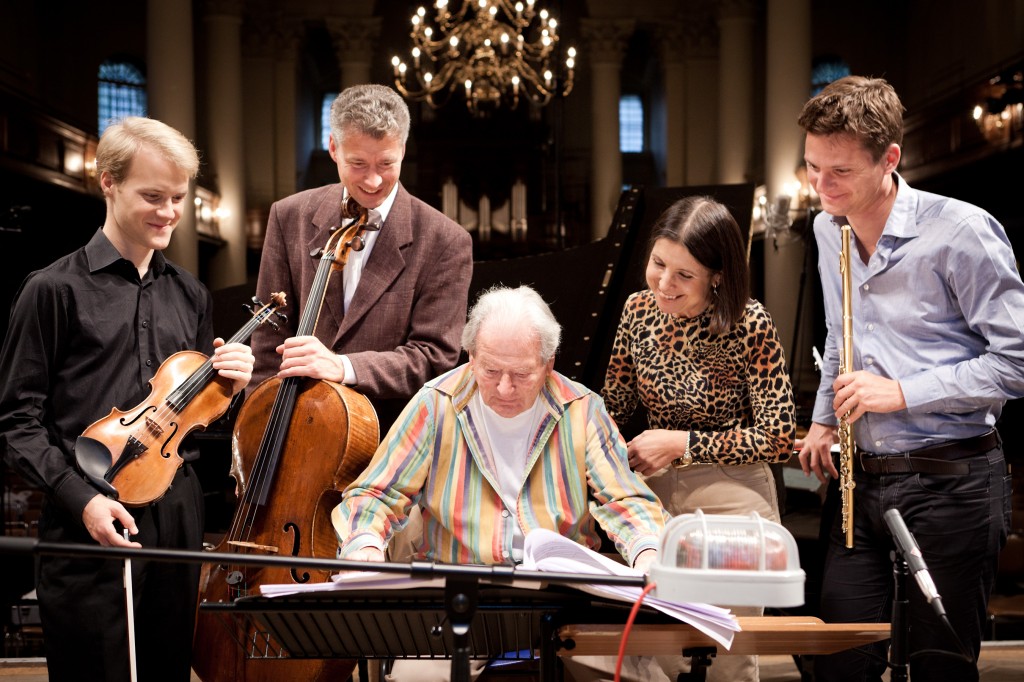
Maria Prinz with Sir Neville Marriner and musicians ((Flute, Violin and Cello) from the Vienna Philharmonic
An extraordinary recording entitled The 20th Century Concerto Grosso has been released on the Chandos label, and it is a must for all those who treasure brilliant playing and rarely heard compositions of high craftsmanship and originality. Quite a bit of the music here even reaches “catchy” status and should be included on one’s playlist for perennial listening. With today’s technological trends in music streaming, featuring many options such as Spotify, Pandora and ITunes, the memorability factor is what general audiences care about most. In other words, will they listen to it again and again or only once?
Although these lesser known works aren’t officially given the Baroque title ”Concerto Grosso” by their composers, like Bloch did with his famous Concerto Grosso No. 1 of 1925 of the same period, they serve the same purpose as the Concerto Grosso musical form did by producing an engaging dialogue between an intimate solo group with a larger ensemble. These works were all written in the 1920’s by three talented Europeans- Czech composer Erwin Schulhoff, Austrian Ernst Krenek, and French composer Vincent D’Indy. These composers have more than a time period and a musical conception in common; they were all unfortunately affected by the Third Reich or anti-Semitism. Schulhoff perished in the Wülzburg concentration camp in 1942. Krenek was frequently labeled as Jewish by the Nazis and his work branded as Entartete Musik. He immigrated to the United States in 1938 after the Anschluss. D’Indy, on the other hand, was a confirmed anti-Semite who actively promoted Richard Wagner’s ideology.
D’Indy, like Wagner, was a despicable person whose music transcends the man. Even though D’Indy’s character makes him the odd man out here, his music belongs with the other concerti on this album. His Concert, Op. 89 (1926), for Piano, Flute and Cello with String Orchestra is not only unique and of a high compositional level, but its Neo-Baroque strands are very accessible to those who want tunes to linger in the musical memory, as it pays more homage to the 18th century form than the other two composers on this recording. Stravinsky’s earlier Pulcinella (1920) or Respighi’s Ancient Airs and Dances (1917 and 1923) immediately come to mind. The music’s humor is palpable, and one walks away humming the tunes with real joy. This composition belongs in the standard repertory alongside the famous Stravinsky and Respighi works. The second most memorable composition here is Schulhoff’s Concerto doppio, WV 89 (1927), for Flute, Piano and String Orchestra with two horns. There is more 20th century dissonance here a la Stravinsky, Bartók, Bloch and Prokofiev. The work is at times danceable and consists of greatly contrasting moods. One can’t help ponder about what might have been had his life not been tragically cut short.
Ernst Krenek is not unknown in the music world. His popular opera Jonny Spielt Auf, which premiered in 1927, made him a star in Europe. It is most inspiring and original, employing jazz elements and multi-cultural influences. His Concertino, Op. 27, written in 1924, is most original in its use of harmony, phrase and rhythm, but has angular, expressionist melodic material that sometimes feels random and uninspired. There are still elements to enjoy, such as the energetic interplay between soloists and orchestra, and the high quality of the playing here.
The Academy of St. Martin in the Fields under Sir Neville Marriner is amazingly polished and energetic in this unknown, difficult material. Pianist Maria Prinz plays virtuosically, devotedly and poetically in all three works. Flutist Karl-Heinz Schutz plays with remarkable beauty and precision, and violinist Christoph Koncz and cellist Robert Nagy play with extraordinary passion and refinement. The acoustic sound of this recording is first rate-natural and brilliant at the same time. One feels as if they are present in the hall with the players.
Kudos to Ms. Prinz and Sir Neville for bringing this music, and the links regarding these three composers, to our attention.
